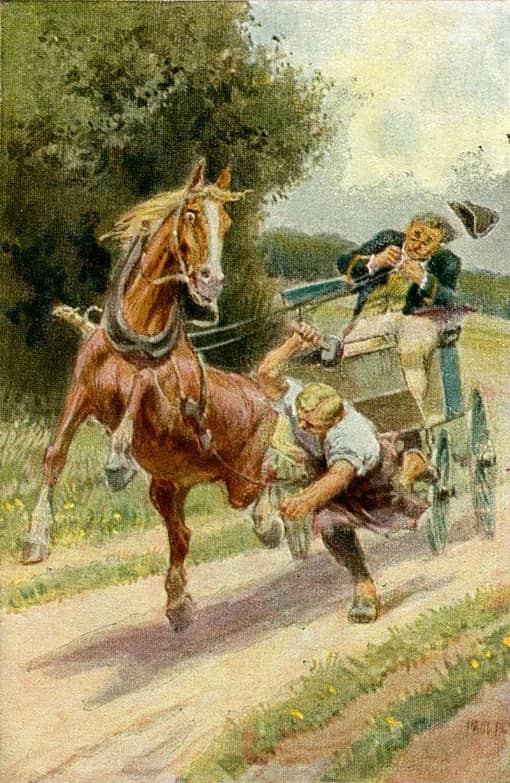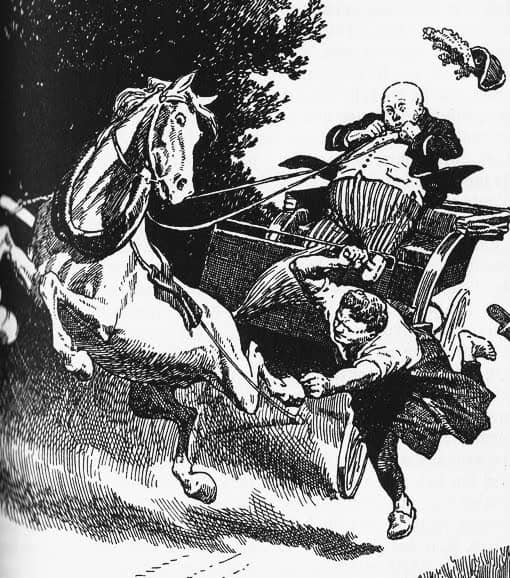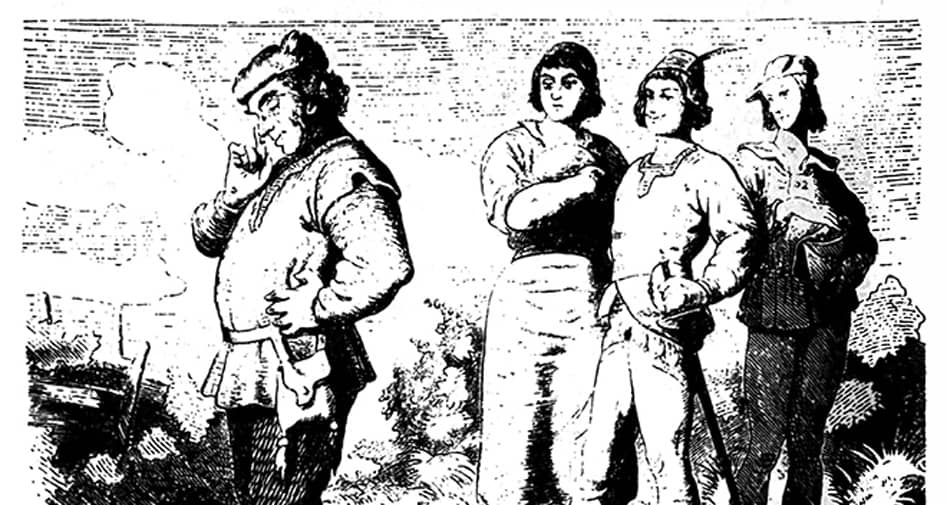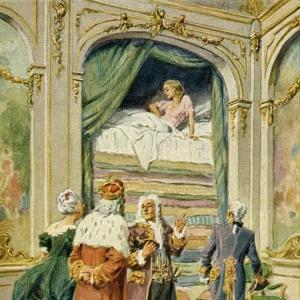Reading time: 6 min
There was once a man who had three sons, and nothing else in the world but the house in which he lived. Now each of the sons wished to have the house after his father’s death; but the father loved them all alike, and did not know what to do. He did not wish to sell the house, because it had belonged to his forefathers, else he might have divided the money amongst them. At last a plan came into his head, and he said to his sons, „Go into the world, and try each of you to learn a trade, and, when you all come back, he who makes the best masterpiece shall have the house.“
The sons were well content with this, and the eldest determined to be a blacksmith, the second a barber, and the third a fencing-master. They fixed a time when they should all come home again, and then each went his way.
It chanced that they all found skilful masters, who taught them their trades well. The blacksmith had to shoe the King’s horses, and he thought to himself, „The house is mine, without doubt.“ The barber only shaved great people, and he too already looked upon the house as his own. The fencing-master got many a blow, but he only bit his lip, and let nothing vex him; „for,“ said he to himself, „If you are afraid of a blow, you’ll never win the house.“
When the appointed time had gone by, the three brothers came back home to their father; but they did not know how to find the best opportunity for showing their skill, so they sat down and consulted together. As they were sitting thus, all at once a hare came running across the field. „Ah, ha, just in time!“ said the barber. So he took his basin and soap, and lathered away until the hare came up. Then he soaped and shaved off the hare’s whiskers whilst he was running at the top of his speed, and did not even cut his skin or injure a hair on his body. „Well done!“ said the old man. „your brothers will have to exert themselves wonderfully, or the house will be yours.“
Soon after, up came a nobleman in his coach, dashing along at full speed. „Now you shall see what I can do, father,“ said the blacksmith. So away he ran after the coach, took all four shoes off the feet of one of the horses whilst he was galloping, and put him on four new shoes without stopping him. „You are a fine fellow, and as clever as your brother,“ said his father; „I do not know to which I ought to give the house.“
 Image: Paul Hey (1867 – 1952)
Image: Paul Hey (1867 – 1952)Then the third son said, „Father, let me have my turn, if you please;“ and, as it was beginning to rain, he drew his sword, and flourished it backwards and forwards above his head so fast that not a drop fell upon him. It rained still harder and harder, till at last it came down in torrents; but he only flourished his sword faster and faster, and remained as dry as if he were sitting in a house. When his father saw this he was amazed, and said, „This is the master-piece, the house is yours!“
His brothers were satisfied with this, as was agreed beforehand; and, as they loved one another very much, they all three stayed together in the house, followed their trades, and, as they had learnt them so well and were so clever, they earned a great deal of money. Thus they lived together happily until they grew old; and at last, when one of them fell sick and died, the two others grieved so sorely about it that they also fell ill, and soon after died. And because they had been so clever, and had loved one another so much, they were all laid in the same grave.

 Learn languages. Double-tap on a word.Learn languages in context with Childstories.org and Deepl.com.
Learn languages. Double-tap on a word.Learn languages in context with Childstories.org and Deepl.com.Backgrounds
Interpretations
Adaptions
Summary
Linguistics
„The Three Brothers“ is a German fairy tale collected by the Brothers Grimm, who were Jacob and Wilhelm Grimm. The story is part of their famous compilation, „Kinder- und Hausmärchen“ („Children’s and Household Tales“), which was first published in 1812. The Brothers Grimm were German academics, linguists, cultural researchers, and authors who collected and published folktales as part of their work on Germanic culture and folklore. Their collection of stories includes well-known tales such as „Cinderella,“ „Hansel and Gretel,“ „Rapunzel,“ and „Snow White.“
The Brothers Grimm aimed to preserve the cultural heritage of these stories, which were passed down through generations via oral tradition. Their collection quickly gained popularity and has since become a significant influence on Western culture and literature, inspiring countless adaptations, retellings, and reinterpretations. „The Three Brothers,“ while not as well-known as some of the other tales in the collection, remains an enduring story that reflects the values and themes prevalent in many Grimm fairy tales, such as the importance of family, hard work, and unity.
„The Three Brothers“ offers several interpretations and themes that can be taken from the story:
The importance of family: The brothers‘ love for one another and their decision to live together after winning the house demonstrates the value of family ties and support. Even when competing against one another, they remain close and continue to care for each other until their deaths.
The value of hard work and perseverance: Each brother learns a trade and works diligently to master it. Their dedication and determination result in impressive skills that not only earn them a living but also help them compete for the house. This theme highlights the importance of commitment and practice in achieving success.
The uniqueness of individual talents: Each brother has a distinct skill that he excels in, and their father values each of their abilities. This theme underscores the significance of recognizing and nurturing individual talents rather than comparing or ranking them against one another.
The power of unity and collaboration: Though the brothers compete for the house, they ultimately decide to live and work together. They pool their skills and resources, leading to a prosperous and happy life. This theme emphasizes the importance of unity and collaboration over individual competition.
The ephemeral nature of life: Despite their skills, success, and love for one another, the brothers eventually grow old and pass away. This theme serves as a reminder that life is fleeting and that people should cherish the time they have with their loved ones.
In summary, „The Three Brothers“ is a tale that highlights the importance of family bonds, hard work, individual talents, unity, and the temporary nature of life.
„The Three Brothers“ is a classic fairy tale that has been adapted and retold in various forms of media, including books, films, and television shows. Here are some notable adaptations of the story.
„The Three Brothers“ film adaptation: In 2011, the story was adapted into a short animated film as part of the „Harry Potter and the Deathly Hallows: Part 1“ movie. The film features three wizard brothers instead of carpenter, miller, and simpleton, and they come across the Deathly Hallows instead of the magical goose.
„The Tale of the Three Brothers“ in Harry Potter: In the Harry Potter book series, J.K. Rowling created her version of the story called „The Tale of the Three Brothers,“ which features three wizard brothers who outwit Death and receive magical objects as a reward.
„The Three Feathers“ by The Brothers Grimm: The Brothers Grimm also collected another fairy tale called „The Three Feathers,“ which has a similar plot to „The Three Brothers.“ In this story, three princes compete to win the kingdom by completing a series of tasks set by their father, the king.
„The Three Billy Goats Gruff“: This is another fairy tale that features three brothers. In this story, the three billy goats have to cross a bridge guarded by a troll, and they use their wits to outsmart the troll.
„The Three Little Pigs“: This is another classic fairy tale that features three brothers. In this story, the three little pigs build houses out of different materials to protect themselves from the big bad wolf.
Overall, „The Three Brothers“ has inspired several adaptations and variations over the years, and its enduring popularity is a testament to the power and appeal of this classic fairy tale.
„The Three Brothers“ is a Brothers Grimm fairy tale about a man with three sons who must decide which of them will inherit the family home. Unable to choose, the father sends his sons into the world to learn trades, promising the house to the one who can create the best masterpiece.
The eldest son becomes a blacksmith, the second a barber, and the third a fencing-master. After a set period, the brothers return home to demonstrate their skills. The barber shaves a hare’s whiskers as it runs, without causing any harm. The blacksmith replaces the shoes of a galloping horse without stopping it. The fencing-master, however, outshines them both when he uses his sword to shield himself from torrential rain without getting wet. Impressed, the father awards the house to the fencing-master.
The brothers, who love each other dearly, decide to live together in the house. They work diligently at their respective trades, earning a comfortable living. As they age, they remain close until one brother falls ill and dies. Grieving, the other two brothers also fall ill and pass away shortly after. In recognition of their talent and love for one another, they are all buried in the same grave.
The fairy tale „The Three Brothers“ by the Brothers Grimm presents a narrative rich in themes of familial love, skill, and competition. From a linguistic perspective, we can analyze the tale through several aspects:
Structure and Plot
The story follows a classic three-part structure, a common feature in fairy tales, where the father sets a challenge, the sons each exhibit their skills, and a resolution is achieved. This structure builds suspense and engages the audience, a hallmark of oral storytelling traditions that the Grimms often drew upon.
Characterization
Father: Presented as a wise and impartial figure, his decision to challenge the sons signifies both a test of skill and character.
The Three Sons: Each son is symbolic of a different trade, showing a diversity of skill and aspiration. The competition among them symbolizes a rite of passage into adulthood.
Themes
Skill and Mastery: Each son must prove his mastery in his chosen trade. The emphasis on skill reflects cultural values regarding the importance of craftsmanship and expertise.
Fairness and Justice: The father’s challenge is designed to ensure fairness, emphasizing justice over favoritism.
Brotherly Love: Despite the competition, the brothers‘ mutual love is highlighted, leading to their harmonious living and joint burial.
Language and Style
Descriptive Language: The details of each son’s achievement (shaving the hare, shoeing the horse, and deflecting the rain) are vividly described to emphasize their abilities.
Dialogue: The dialogue primarily serves to propel the plot and reveal character intentions, such as the father’s admiration and the sons‘ determination.
Repetition: The repetitive structure of each son attempting to win the house mirrors the oral tradition, making it easier to remember and transmit.
Symbolism
House: Symbolizes heritage and continuity, the familial legacy that connects the past to the future.
Trades: Each trade represents not just a skill, but a metaphor for ways of interacting with and mastering the world.
Moral and Resolution
The tale concludes with a peaceful resolution, as all brothers live and work together harmoniously. The moral can be interpreted as the value of cooperation and love over competition, reflecting an ideal of familial unity.
Overall, „The Three Brothers“ combines elements of competition and love, weaving them into a narrative that is both entertaining and instructive. Its linguistic elements serve to enhance the timeless themes of skill, justice, and familial harmony.
Information for scientific analysis
Fairy tale statistics | Value |
|---|---|
| Number | KHM 124 |
| Aarne-Thompson-Uther-Index | ATU Typ 654 |
| Translations | DE, EN, DA, ES, FR, PT, HU, IT, JA, NL, PL, RO, RU, TR, VI, ZH |
| Readability Index by Björnsson | 32.3 |
| Flesch-Reading-Ease Index | 79.8 |
| Flesch–Kincaid Grade-Level | 7.8 |
| Gunning Fog Index | 10.5 |
| Coleman–Liau Index | 7.6 |
| SMOG Index | 8.4 |
| Automated Readability Index | 8.7 |
| Character Count | 3.439 |
| Letter Count | 2.628 |
| Sentence Count | 29 |
| Word Count | 662 |
| Average Words per Sentence | 22,83 |
| Words with more than 6 letters | 63 |
| Percentage of long words | 9.5% |
| Number of Syllables | 813 |
| Average Syllables per Word | 1,23 |
| Words with three Syllables | 23 |
| Percentage Words with three Syllables | 3.5% |

 Facebook
Facebook  Whatsapp
Whatsapp  Messenger
Messenger  Telegram
Telegram Reddit
Reddit














